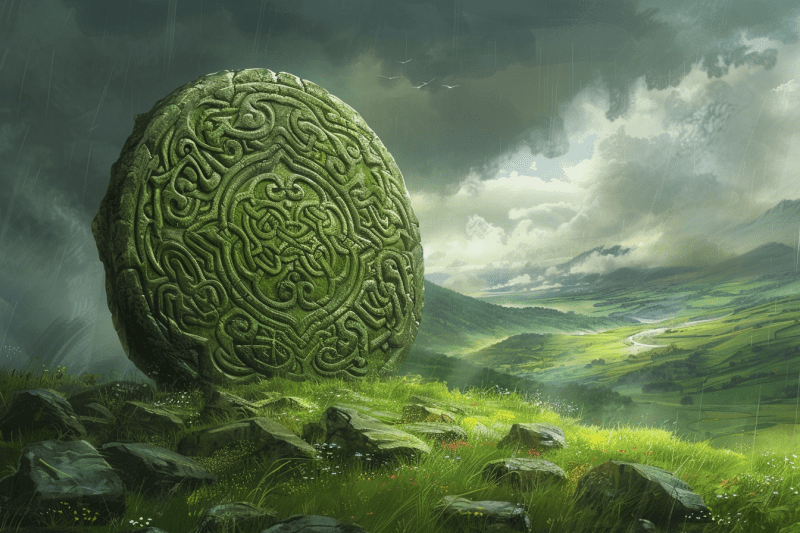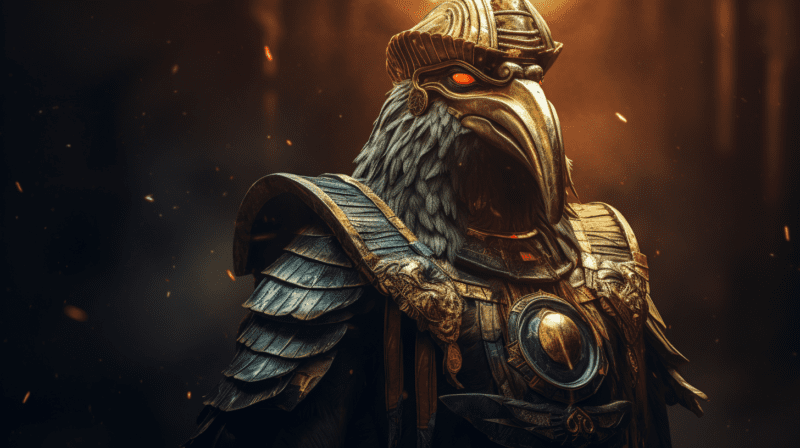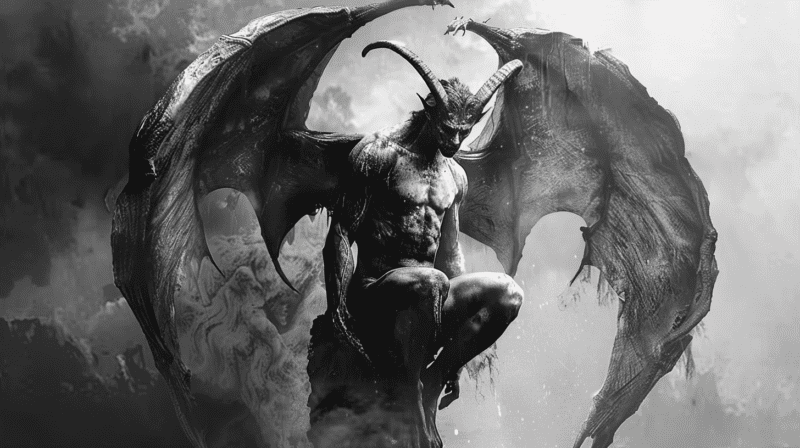Quetzalcoatl is a deity in Mesoamerican mythology, revered by many cultures in the region, including the Aztecs, Mayans, and Toltecs. He is often depicted as a feathered serpent and is associated with creation, fertility, and wisdom. Quetzalcoatl was believed to have taught humans various skills, including agriculture, weaving, and metallurgy. He was also associated with the planet Venus and was believed to have been responsible for the cycles of life and death. Quetzalcoatl’s influence can be seen in various aspects of Mesoamerican culture, including art, architecture, and religion. He remains an important figure in modern-day Mexico, where he is celebrated during the festival of the Day of the Dead.
Origins & Meaning
The Aztecs and other Mesoamerican cultures spoke the Nahuatl language, which is where the name “Quetzalcoatl” comes from. The word is a combination of two Nahuatl terms: “quetzal” and “coatl.”
“Quetzal” refers to the quetzal bird, a vibrant and sacred bird in Mesoamerican culture known for its colorful feathers. The quetzal bird was considered a symbol of beauty, freedom, and divinity. Its feathers were highly prized and associated with nobility and royalty.
“Coatl” means serpent or snake in Nahuatl. In Mesoamerican mythology, the serpent was a powerful symbol associated with creation, fertility, and wisdom. The combination of “quetzal” and “coatl” in Quetzalcoatl’s name represents the fusion of these two significant symbols, the quetzal bird and the serpent.
Therefore, the name Quetzalcoatl can be interpreted as “Feathered Serpent,” symbolizing the divine union of the bird and the snake. The quetzal bird and serpent are representations of Quetzalcoatl’s dual roles as a deity of both the heavens and the earth.
Quetzalcoatl, being a widely revered deity in Mesoamerican mythology, has been interpreted and represented in various ways across different cultures and time periods. Here are some notable interpretations:
- Aztec Interpretation: In Aztec culture, Quetzalcoatl was seen as a creator god and a patron of civilization. He was associated with wisdom, art, and knowledge. The Aztecs believed that Quetzalcoatl had created the current world and humanity through his sacrifice. He was often depicted as a feathered serpent, with the feathers representing his connection to the heavens and the serpent symbolizing his association with the earth.
- Toltec Interpretation: The Toltecs, an earlier civilization in Mesoamerica, also revered Quetzalcoatl. They considered him to be a cultural hero and a bringer of civilization. In Toltec art, Quetzalcoatl was depicted as a bearded man, often wearing a feathered headdress and holding a scepter. This representation emphasized his role as a wise teacher and leader.
- Maya Interpretation: Among the Maya civilization, Quetzalcoatl was known as Kukulkan. He was seen as a benevolent deity associated with wind, rain, and fertility. The Maya believed that Kukulkan brought prosperity and agricultural abundance. In Maya art, he was often portrayed as a feathered serpent, similar to the Aztec depiction.
- Post-Conquest Interpretations: After the Spanish conquest of Mesoamerica, the image of Quetzalcoatl underwent significant changes due to the influence of Catholicism. Some indigenous communities merged Quetzalcoatl with the figure of St. Thomas the Apostle, resulting in a syncretic deity known as “Quetzalcoatl-Thomas.” This blending of religious beliefs aimed to preserve indigenous traditions while adopting the new Christian faith.
Overall, the interpretations and representations of Quetzalcoatl varied across cultures, but they all emphasized his connection to creation, wisdom, and the natural world. Despite the differences, Quetzalcoatl remained a central figure in Mesoamerican mythology, representing the complex and diverse beliefs of the region.
Mythology and Attributes
In Mesoamerican mythology, Quetzalcoatl holds a prominent role and possesses various characteristics that are revered by different cultures.
Firstly, Quetzalcoatl is associated with creation. He is believed to have played a vital role in the formation of the world and humanity. According to some myths, Quetzalcoatl sacrificed himself to create the current world and to give life to humans. This act of sacrifice and creation underscores his significance as a divine being.
Secondly, Quetzalcoatl is closely linked to wind. He is often referred to as the “Ehecatl,” which means “wind” in Nahuatl, the language of the Aztecs. Quetzalcoatl was believed to control the winds and was associated with the breath of life. His association with wind symbolizes his power to bring change, renewal, and the movement of life forces.
Additionally, Quetzalcoatl is connected to fertility. He is seen as a deity who brings abundance and prosperity to the land. Quetzalcoatl’s role as a fertility god is linked to his association with wind, as wind was believed to carry the life-giving forces necessary for agricultural growth and reproduction.
In terms of physical attributes, Quetzalcoatl is commonly depicted as a feathered serpent. This representation combines the bird-like qualities of the quetzal and the serpent, symbolizing the union of the heavens and the earth. The feathers represent his connection to the celestial realms, while the serpent represents his association with the earthly realm. This duality highlights his role as a bridge between the spiritual and physical worlds.
Quetzalcoatl is also portrayed with other physical characteristics, such as a bearded face, often depicted as fair-skinned, and sometimes wearing a feathered headdress or regalia associated with his divine status.
Overall, Quetzalcoatl’s role in Mesoamerican mythology encompasses creation, wind, and fertility. His physical representation as a feathered serpent further emphasizes his connection to both the celestial and earthly realms, making him a central and revered figure in Mesoamerican cultures.
Worship and Rituals
The worship of Quetzalcoatl held a significant place in the religious practices of ancient Mesoamerican civilizations, particularly among the Aztecs and the Maya. The rituals and ceremonies dedicated to Quetzalcoatl were elaborate and often involved human sacrifices. Temples and shrines were built to honor and appease him.
Rituals and ceremonies dedicated to Quetzalcoatl varied across different cultures and time periods, but some common practices can be identified. One such ritual was the “New Fire Ceremony,” which was conducted every 52 years to mark the beginning of a new cycle in the Mesoamerican calendar. This ceremony involved extinguishing all fires and then creating a new fire through friction. The new fire was seen as a symbol of Quetzalcoatl’s renewal and the rejuvenation of the world.
Human sacrifices were also an integral part of the worship of Quetzalcoatl, particularly among the Aztecs. Sacrifices were believed to be necessary to maintain the cosmic balance and ensure the continued existence of the world. The victims, often prisoners of war or volunteers, were ritually killed as an offering to Quetzalcoatl. The sacrifices were performed on top of pyramids or in temples dedicated to the deity.
Temples and shrines dedicated to Quetzalcoatl were of great importance in Mesoamerican civilizations. These structures were typically built on elevated platforms and adorned with elaborate carvings and sculptures. The most famous temple dedicated to Quetzalcoatl is the Temple of the Feathered Serpent, also known as the Pyramid of Quetzalcoatl, at the archaeological site of Teotihuacan in Mexico. This temple complex features intricate reliefs depicting Quetzalcoatl and other deities associated with him.
The temples and shrines served as sacred spaces for religious rituals and ceremonies. They were believed to be the physical manifestations of Quetzalcoatl’s presence and power. Pilgrimages to these sites were common, and people would make offerings and perform rituals to seek the favor and blessings of Quetzalcoatl.
Legacy and Influence
Quetzalcoatl’s legacy in Mesoamerican cultures is profound and continues to be celebrated and revered to this day. His influence can be seen in various aspects of Mesoamerican art, architecture, and literature.
In art, Quetzalcoatl is often depicted as a feathered serpent, a motif that became a prominent symbol in Mesoamerican iconography. This representation can be found in murals, sculptures, and codices, showcasing his importance and widespread recognition. The feathered serpent motif continued to be used in the art of subsequent Mesoamerican civilizations, such as the Mixtecs and the Zapotecs, demonstrating Quetzalcoatl’s enduring influence.
In architecture, Quetzalcoatl’s presence is evident in the design and construction of temples and pyramids. The Temple of the Feathered Serpent in Teotihuacan is a prime example, featuring intricate reliefs and sculptures depicting Quetzalcoatl. His imagery is also found in other architectural sites, such as Tula and Chichen Itza, where temples dedicated to him showcase his significance in Mesoamerican religious practices.
Quetzalcoatl’s influence extends to Mesoamerican literature as well. In Aztec and Maya codices, Quetzalcoatl is often depicted as a central figure, with stories and myths surrounding his deeds and adventures. His role as a creator and bringer of civilization is a recurring theme in these narratives, emphasizing his importance as a divine being in Mesoamerican cosmology.
In modern times, Quetzalcoatl continues to be celebrated and revered in various forms. In Mexico, particularly during the festival of Día de los Muertos (Day of the Dead), Quetzalcoatl is honored as an ancestral deity and is often depicted in colorful masks and costumes. The festival serves as a way to remember and pay homage to the ancient Mesoamerican cultures that worshipped Quetzalcoatl.
Furthermore, Quetzalcoatl’s legacy is also celebrated in contemporary indigenous communities, where rituals and ceremonies dedicated to him are still practiced. These communities maintain a deep connection to their ancestral beliefs and continue to honor Quetzalcoatl as a powerful and benevolent deity.
Quetzalcoatl’s lasting legacy in Mesoamerican cultures is evident in the realms of art, architecture, and literature. His influence can be seen in the iconic feathered serpent motif, the design of temples and pyramids, and the narratives and myths recorded in codices. Moreover, Quetzalcoatl’s reverence and celebration persist in modern times, both in cultural festivals and in the practices of indigenous communities, highlighting his enduring significance in Mesoamerican spirituality and cultural identity.
Key Takeaways
- Quetzalcoatl holds immense significance in Mesoamerican mythology and culture, leaving an enduring impact on various aspects of society. As a deity, Quetzalcoatl was revered as a powerful and benevolent force, associated with creation, fertility, and the arts. His influence extended to numerous realms, including religion, cosmology, social structure, and even daily life.
- In Mesoamerican mythology, Quetzalcoatl played a central role as a creator god. He was believed to have participated in the creation of the world and humanity, shaping and nurturing the cosmos. Quetzalcoatl was also associated with the cycles of life and death, symbolizing the continuous renewal and regeneration of existence.
- Quetzalcoatl’s influence on society was far-reaching. He was considered the patron deity of priests, artists, and intellectuals, reflecting his association with knowledge, wisdom, and creativity. His teachings and guidance were highly valued, shaping the moral and ethical codes of Mesoamerican civilizations. Quetzalcoatl was seen as a model of virtue, promoting peace, justice, and compassion among individuals and communities.
- The worship of Quetzalcoatl was deeply ingrained in Mesoamerican culture. Rituals, ceremonies, and sacrifices were conducted to honor and appease him, ensuring the harmony and balance of the cosmos. Temples and shrines dedicated to Quetzalcoatl served as sacred spaces for worship, pilgrimage, and offerings. The architectural marvels created in his honor, such as the Temple of the Feathered Serpent in Teotihuacan, stand as a testament to his significance in Mesoamerican society.
- Quetzalcoatl’s impact on Mesoamerican society extended beyond religious practices. His imagery, such as the feathered serpent motif, became a prominent symbol in Mesoamerican art, reflecting his influence on artistic expression. His presence in literature, codices, and oral traditions further solidified his role as a central figure in Mesoamerican cultural narratives.
- Even in modern times, Quetzalcoatl’s legacy continues to be celebrated and revered. Festivals and rituals dedicated to him, such as Día de los Muertos, showcase the enduring impact of his worship and the preservation of Mesoamerican traditions. Indigenous communities maintain a connection to their ancestral beliefs, honoring Quetzalcoatl as a symbol of cultural identity and spiritual heritage.
In summary, Quetzalcoatl holds immense significance in Mesoamerican mythology and culture. His role as a creator god, patron of priests and artists, and embodiment of virtue shaped various aspects of society. The worship of Quetzalcoatl, the architectural marvels dedicated to him, and his presence in art and literature emphasize his enduring impact on Mesoamerican civilization. Even in modern times, Quetzalcoatl’s legacy continues to be celebrated, highlighting the lasting influence of this revered deity.





